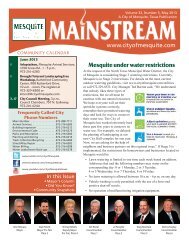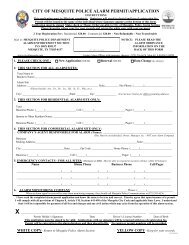airport/documents/Mesquite Master Plan Final.pdf - The City of ...
airport/documents/Mesquite Master Plan Final.pdf - The City of ...
airport/documents/Mesquite Master Plan Final.pdf - The City of ...
Create successful ePaper yourself
Turn your PDF publications into a flip-book with our unique Google optimized e-Paper software.
to produce a market share projection.<br />
This method has the same limitations<br />
as trend line projections, but can<br />
provide a useful check on the validity <strong>of</strong><br />
other forecasting techniques.<br />
It is important to note that one should<br />
not assume a high level <strong>of</strong> confidence in<br />
forecasts that extend beyond five years.<br />
Facility and financial planning usually<br />
require at least a 10-year view, since it<br />
<strong>of</strong>ten takes more than five years to<br />
complete a major facility development<br />
program. However, it is important to<br />
use forecasts which do not overestimate<br />
revenue-generating capabilities or<br />
understate demand for facilities needed<br />
to meet public (user) needs.<br />
A wide range <strong>of</strong> factors is known to<br />
influence the aviation industry and can<br />
have significant impacts on the extent<br />
and nature <strong>of</strong> air service provided in<br />
both the local and national markets.<br />
Technological advances in aviation have<br />
historically altered, and will continue to<br />
change, the growth rates in aviation<br />
demand over time. <strong>The</strong> most obvious<br />
example is the impact <strong>of</strong> jet aircraft on<br />
the aviation industry, which resulted in<br />
a growth rate that far exceeded<br />
expectations. Such changes are<br />
difficult, if not impossible, to predict,<br />
and there is simply no mathematical<br />
way to estimate their impacts. Using a<br />
broad spectrum <strong>of</strong> local, regional, and<br />
national socioeconomic and aviation<br />
information, and analyzing the most<br />
current aviation trends, forecasts are<br />
presented in the following sections.<br />
<strong>The</strong> following forecast analysis<br />
examines each <strong>of</strong> the aviation demand<br />
categories expected at <strong>Mesquite</strong> Metro<br />
Airport through 2025. Each segment<br />
2-5<br />
will be examined individually, and then<br />
collectively, to provide an<br />
understanding <strong>of</strong> the overall aviation<br />
activity at <strong>Mesquite</strong> Metro Airport<br />
through 2025.<br />
AIRPORT SERVICE AREA<br />
<strong>The</strong> initial step in determining the<br />
general aviation demand for an <strong>airport</strong><br />
is to define its generalized service area.<br />
<strong>The</strong> <strong>airport</strong> service area is determined<br />
primarily by evaluating the location <strong>of</strong><br />
competing <strong>airport</strong>s, their capabilities<br />
and services, and their relative<br />
attraction and convenience. Also, to aid<br />
in identifying the generalized service<br />
area for <strong>Mesquite</strong> Metro Airport, an<br />
analysis <strong>of</strong> the billing addresses for<br />
most <strong>of</strong> the based aircraft owners was<br />
conducted. It should be noted that<br />
aviation demand <strong>of</strong>ten crosses<br />
geographical and political boundaries.<br />
<strong>The</strong> <strong>airport</strong> service area is a generalized<br />
geographical area where there is a<br />
potential market for <strong>airport</strong> services.<br />
Access to general aviation <strong>airport</strong>s,<br />
commercial air service, and<br />
transportation networks enter into the<br />
equation to determine the size <strong>of</strong> a<br />
service area, as well as the quality <strong>of</strong><br />
aviation facilities, distance, and other<br />
subjective criteria. Typically, the<br />
service area for a rural general aviation<br />
<strong>airport</strong> can extend up to 30 miles.<br />
General aviation <strong>airport</strong>s, especially<br />
reliever <strong>airport</strong>s in urban settings, can<br />
expect a service area to extend outward<br />
up to 30 miles.<br />
<strong>The</strong> proximity and level <strong>of</strong> service<br />
<strong>of</strong>fered by other <strong>airport</strong>s are largely the<br />
defining factors when describing the




